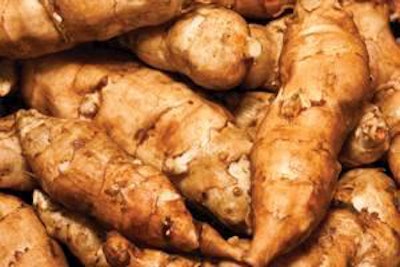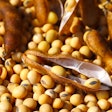
Inulin has been making headlines for a few years now, but it remains a little-known ingredient and is even less used in the feed industry. As a functional fiber, inulin can be used in a comprehensive nutrition program in diets without antibiotics to “feed” the beneficial bacteria at the exclusion of the pathogenic ones. To better understand how to use this ingredient, it is important to know both its origin and functionality.
Gut health
Prebiotic or “functional” fibers are non-digestible oligosaccharides that can be used as nourishment to beneficial bacterial, such as lactobacteria and bifidobacteria. When these bacterial populations are enhanced by selectively feeding them, they work to the benefit of the host (animal) by excluding other potentially pathogenic bacteria as they compete with them for nutrients and “space.” Today, this approach is used quite frequently in diets devoid of antimicrobial agents, especially by nutritionists who appreciate the relationship between a healthy gut microflora and animal growth performance.
It is well known that most food-borne bacteria are eliminated at the stomach through secretion of hydrochloric acid that creates a very acidic, and thus highly unfavorable, environment, especially for certain pathogens such as Escherichia coli. In most young animals, however, such mechanism is not yet fully developed, and any source of acidification is secured through the bacteria inhabiting the stomach; such an example are lactobacteria that feed on lactose and produce lactic acid. Similar results can be obtained by providing another source of carbohydrates that is less expensive than lactose, namely oligosaccharides, most frequently in the form of inulin. Today, it is widely accepted that functional fibers, including inulin, can stimulate the growth of acid-producing bacteria in the stomach, thus helping in its acidification.
Controlling pathogenic bacteria
At the level of the small intestine, pathogenic bacteria cannot be controlled through acidification as the animal’s organism counteracts any such attempt by secreting copious amounts of bicarbonate to maintain the alkaline environment, which is needed for the enzymatic digestion of feed. Nevertheless, through competitive exclusion, pathogenic bacteria can be minimized as they cannot outperform the beneficial ones if the latter are being supplemented with an external source of nutrients; that would be, of course, functional fibers. For example, lactobacteria and bifidobacteria, which thrive on oligosaccharides, will outgrow coliforms and Salmonella, which require excess protein to thrive and colonize the gut before they start secreting their toxins.
In the large intestine, a microflora again dominated by beneficial bacterial will produce volatile fatty acids (such as butyric acid) in such amounts that they will further reduce the chances of survival for any remaining acid-sensitive pathogenic bacteria. Of course, it is possible to provide butyric acid through the feed, but not only is this a very expensive ingredient, it only serves in a part of the whole process. This is why it is considered better to work indirectly by enhancing the complete process through supporting the natural beneficial microflora.
Sources of oligosaccharides
Inulin is not the only oligosaccharide available, but it is indeed one of the major ones and certainly the most widely researched functional fiber. Inulin-rich ingredients include certain root plants such as artichokes, chicory, onions, leeks and asparagus. Inulin is clearly non-digestible by pigs and poultry, due to the way its fructose molecules are linked to each other, but it is due to this lack of digestibility that inulin owes its considerable properties as a functional fiber.
Because chicory is by far the richest source of inulin in nature (approximately 16 percent inulin), this is the primary source of commercial inulin products. Crystalline inulin is a hot-water extract. It is slightly sweet and highly soluble in warm water, making it an ideal ingredient for milk replacers. It is completely soluble in the gut as soon as it reaches the stomach.
Pure versus wholesome
Today, there are two schools of thought regarding the proper source of oligosaccharides in diets for young monogastric animals. One supports the use of purified compounds, such as crystalline inulin. The other requires the use of the original material, such as dried chicory pulp. There are certain pros and cons for each approach.
Purified oligosaccharides can simplify logistics and offer advantages in terms of transportation costs and premix package size to manufacturers of nutritional supplements. They can also be used to provide a higher dietary concentration, avoiding the undesirable increase in dietary “crude fiber” associated with the source raw materials. Nevertheless, they are more expensive to use, and they are also single-compound products, excluding a wider variety of similar oligosaccharides that exist in whole ingredients. This is the major benefit of using whole ingredients that contain a wide array of oligosaccharides other than inulin.
Thus, instead of using pure inulin, it is possible to incorporate in a piglet or broiler feed a small amount of whole ingredients, such as chicory pulp, beet pulp, and apple pomace, just to name a few. This provides a smaller amount of functional fibers, but a much enriched variety. Currently, there is no scientific evidence to suggest one method is better than the other, and as such, each nutritionist is using his own judgment to decide how to proceed.
Other uses
Apart from regulating gut microflora, using inulin (and similar such oligosaccharides) has been shown to offer additional benefits, including the following:
- Enhancement of the immune system functions at the gut level
- Increased calcium absorption, which can have beneficial effects in aged sows and late-cycle hens
- Regulation of bowel movements, especially important for gestating sows
- Reduced ammonia emission, with implications on environmental protection
Growth performance
In many trials, supplementation with inulin has yielded no positive effects. This is only logical to expect as such an “additive” cannot have a blanket application due to its nature. That is, we should expect a positive effect on animal performance only when such performance is depressed due to exposure to pathogenic bacteria. If the feed contains other, more direct, antimicrobial agents, then the role of functional fibers diminishes. Or, if the environment is particularly clean and animal health is generally good, then even antibiotics will fail to further improve animal performance!
This is why functional fibers, of which the prime example of inulin has been discussed here, are used mostly in diets devoid of antibiotics. However, it must be emphasized that alone they cannot fully replace these powerful antimicrobial agents. Instead, functional fibers should be used as part of a more inclusive nutrition program that includes low dietary protein, and supplementation with certain organic acids, and even zinc oxide, if permitted.


















